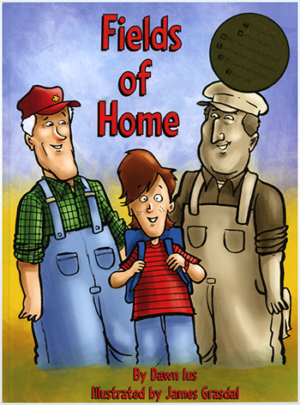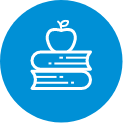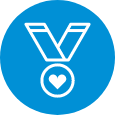
Grade 1 Learning Objectives for “Fields of Home”
Jump to Subject

English Language Arts
General Learning Objective
1. Students will listen, speak, read, write, view and represent to explore thoughts, ideas, feelings and experiences.
Specific Learning Objectives
1.1 Discover and explore
Express ideas and develop understanding
- Share personal experiences that are clearly related to oral, print and other media texts
- Talk with others about something recently learned
- Make observations about activities, experiences with oral, print and other media texts
Experiment with language and forms
- Experiment with different ways of exploring and developing stories, ideas and experiences
1.2 Clarify and Extend
Consider the ideas of others
- Listen and respond appropriately to experiences and feelings shared by others
Extend understanding
- Ask questions to get additional ideas and information on topics of interest
General Learning Objective
2. Students will listen, speak, read, write, view and represent to comprehend and respond personally and critically to oral, print and other media texts.
Specific Learning Objectives
2.1 Use Strategies and Cues
Use prior knowledge
- Use knowledge of how oral language is used in a variety of contexts to construct and confirm meaning
- Use previous experience and knowledge of oral language to make connections to the meaning of oral, print and other media texts
- Use knowledge of context, pictures, letters, words, sentences, predictable patterns and rhymes in a variety of oral, print and other media texts to construct and confirm meaning
- Use knowledge of print, pictures, book covers and title pages to construct and confirm meaning
Use comprehension strategies
- Talk about print or other media texts previously read or viewed
- Identify the main idea or topic of simple narrative and expository texts
Use textual cues
- Preview book cover, pictures and location of text to assist with constructing and confirming meaning
2.2 Respond to Text
Experience various texts
- Participate in shared listening, reading and viewing experiences, using oral, print and other media texts from a variety of cultural traditions and genres, such as poems, storytelling by elders, pattern books, audiotapes, stories and cartoons
Construct meaning from texts
- Relate aspects of stories and characters to personal feelings and experiences
- Retell interesting or important aspects of oral, print and other media texts
- Tell or represent the beginning, middle and end of stories
- Tell, represent or write about experiences similar or related to those in oral, print and other media texts
- Tell what was liked or disliked about oral, print and other media texts
2.3 Understand Forms, Elements and Techniques
Understand forms and genres
- Distinguish differences in the ways various oral, print and other media texts are organized
Understand techniques and elements
- Tell what characters do or what happens to them in a variety of oral, print and other media texts
General Learning Objective
3. Students will listen, speak, read, write, view and represent to manage ideas and information.
Specific Learning Objectives
3.1 Plan and Focus
Focus attention
- Explore and share own ideas on topics of discussion and study
- Connect information from oral, print and other media texts to topics of study
3.2 Select and Process
Access information
- Use text features, such as illustrations, titles and opening shots in video programs, to access information
- Use questions to find specific information in oral, print and other media texts
3.3 Organize, Record and Evaluate
Evaluate information
- Recognize and use gathered information to communicate new learning
3.4 Share and Review
Share ideas and information
- Share ideas and information from oral, print and other media texts with familiar audiences
- Answer questions directly related to texts
General Learning Objective
4. Students will listen, speak, read, write, view and represent to enhance the clarity and artistry of communication.
Specific Learning Objectives
4.3 Present and Share
Demonstrate attentive listening and viewing
- Ask questions to clarify information
- Be attentive and show interest during listening or viewing activities
General Learning Objective
5. Students will listen, speak, read, write, view and represent to respect, support and collaborate with others.
Specific Learning Objectives
5.1 Respect Others and Strengthen Community
Relate texts to culture
- Talk about other times, places and people after exploring oral, print and other media texts from various communities

Health
Topic: Personal Health
General Learning Objective
Wellness Choices
Students will make responsible and informed choices to maintain health and to promote safety for self and others.
Specific Learning Objectives
W–1.4
- Identify physical characteristics that make themselves both similar to and different from others
Topic: Safety and Responsibility
General Learning Objective
Wellness Choices
Students will make responsible and informed choices to maintain health and to promote safety for self and others.
Specific Learning Objectives
W–1.8
- Determine reasons for and apply safety rules at home and at school; e.g., demonstrate fire safety behaviours
Topic: Learning Strategies
General Learning Objective
Life Learning Choices
Students will use resources effectively to manage and explore life roles and career opportunities
and challenges.
Specific Learning Objectives
L–1.4
- Define a goal, and recognize that setting goals helps accomplish tasks
Topic: Life Roles and Career Development
General Learning Objective
Life Learning Choices
Students will use resources effectively to manage and explore life roles and career opportunities
and challenges.
Specific Learning Objectives
L–1.5
- Recognize interests, strengths and skills of self

Social Studies
Topic: 1.1 My World: Home, School, and Community
General Learning Objective
Students will demonstrate an understanding and appreciation of how identity and self-esteem are
enhanced by their sense of belonging in their world and how active members in a community contribute
to the well-being, growth and vitality of their groups and communities.
Specific Learning Objectives
1.1.1
Value self and others as unique individuals in relation to their world:
1.1.2
Value the groups and communities to which they belong:
1.1.3
Examine how they belong and are connected to their world by exploring and reflecting upon the following questions for inquiry:
1.1.4
Determine what makes their communities thrive by exploring and reflecting upon the
following questions for inquiry:
1.1.5
Distinguish geographic features in their own community from other communities by
exploring and reflecting upon the following questions for inquiry:
Topic: 1.2 Moving Forward with the Past: My Family, My History and My Community
General Learning Objective
Students will demonstrate an understanding and appreciation of how changes over time have affected their families and influenced how their families and communities are today.
Specific Learning Objectives
1.2.1
Appreciate how stories and events of the past connect their families and communities to
the present:
1.2.2
analyze how their families and communities in the present are influenced by events or people of the past by exploring and reflecting upon the following questions for inquiry:
Topic: Dimensions of Thinking
General Learning Objective
Skills and Processes
Specific Learning Objectives
1.S.2
develop skills of historical thinking: